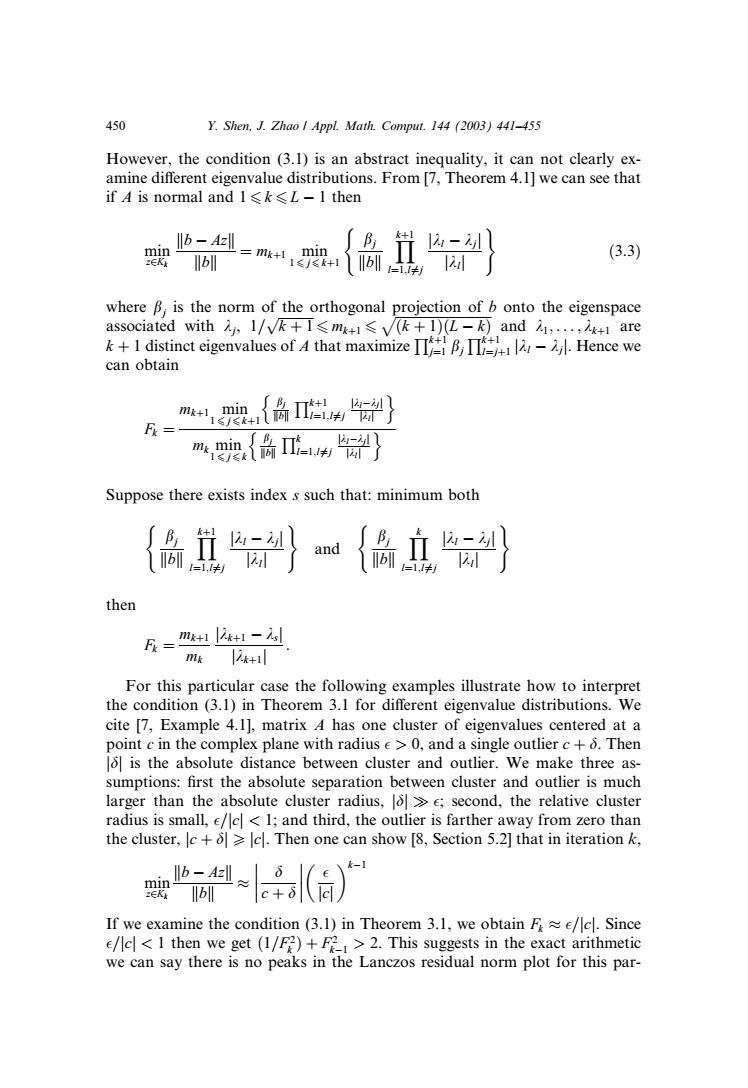正在加载图片...

450 Y.Shen,J.Zhao Appl.Math.Comput.144 (2003)441-455 However,the condition (3.1)is an abstract inequality,it can not clearly ex- amine different eigenvalue distributions.From [7,Theorem 4.1]we can see that if A is normal and I≤k≤L-1then Ib-Az‖ (3.3) where B,is the norm of the orthogonal projection of b onto the eigenspace associated with,l/vk+T≤mk+1≤Vk+IL-万,and1,.,k+iare +I distinct eigenvalues of 4 that maximizeHence we can obtain {将} mg+1,min F= m映{备 Suppose there exists index s such that:minimum both then F=m+1- mk k+1 For this particular case the following examples illustrate how to interpret the condition (3.1)in Theorem 3.1 for different eigenvalue distributions.We cite [7,Example 4.1],matrix A has one cluster of eigenvalues centered at a point c in the complex plane with radius e>0,and a single outlier c+6.Then is the absolute distance between cluster and outlier.We make three as- sumptions:first the absolute separation between cluster and outlier is much larger than the absolute cluster radius,>e;second,the relative cluster radius is small,e/c<1;and third,the outlier is farther away from zero than the cluster,c+>c.Then one can show [8,Section 5.2]that in iteration k, 婴l) If we examine the condition (3.1)in Theorem 3.1,we obtain Fec.Since e/lcl<1 then we get (1/F2)+F2>2.This suggests in the exact arithmetic we can say there is no peaks in the Lanczos residual norm plot for this par-However, the condition (3.1) is an abstract inequality, it can not clearly examine different eigenvalue distributions. From [7, Theorem 4.1] we can see that if A is normal and 1 6 k 6 L 1 then min z2Kk kb Azk kbk ¼ mkþ1 min 1 6 j 6 kþ1 bj kbk Y kþ1 l¼1;l6¼j jkl kjj jklj ( ) ð3:3Þ where bj is the norm of the orthogonal projection of b onto the eigenspace associated with kj, 1= ffiffiffiffiffiffiffiffiffiffiffi k þ 1 p 6 mkþ1 6 ffiffiffiffiffiffiffiffiffiffiffiffiffiffiffiffiffiffiffiffiffiffiffiffiffiffiffiffiffi ðk þ 1ÞðL kÞ p and k1; ... ; kkþ1 are k þ 1 distinct eigenvalues of A that maximize Qkþ1 j¼1 bj Qkþ1 l¼jþ1 jkl kjj. Hence we can obtain Fk ¼ mkþ1 min 1 6 j 6 kþ1 bj kbk Qkþ1 l¼1;l6¼j jklkjj jklj n o mk min 1 6 j 6 k bj kbk Qk l¼1;l6¼j jklkjj jklj n o Suppose there exists index s such that: minimum both bj kbk Y kþ1 l¼1;l6¼j jkl kjj jklj ( ) and bj kbk Y k l¼1;l6¼j jkl kjj jklj ( ) then Fk ¼ mkþ1 mk jkkþ1 ksj jkkþ1j : For this particular case the following examples illustrate how to interpret the condition (3.1) in Theorem 3.1 for different eigenvalue distributions. We cite [7, Example 4.1], matrix A has one cluster of eigenvalues centered at a point c in the complex plane with radius > 0, and a single outlier c þ d. Then jdj is the absolute distance between cluster and outlier. We make three assumptions: first the absolute separation between cluster and outlier is much larger than the absolute cluster radius, jdj ; second, the relative cluster radius is small, =jcj < 1; and third, the outlier is farther away from zero than the cluster, jc þ dj P jcj. Then one can show[8, Section 5.2] that in iteration k, min z2Kk kb Azk kbk d c þ d jcj k1 If we examine the condition (3.1) in Theorem 3.1, we obtain Fk =jcj. Since =jcj < 1 then we get ð1=F 2 k Þ þ F 2 k1 > 2. This suggests in the exact arithmetic we can say there is no peaks in the Lanczos residual norm plot for this par- 450 Y. Shen, J. Zhao / Appl. Math. Comput. 144 (2003) 441–455